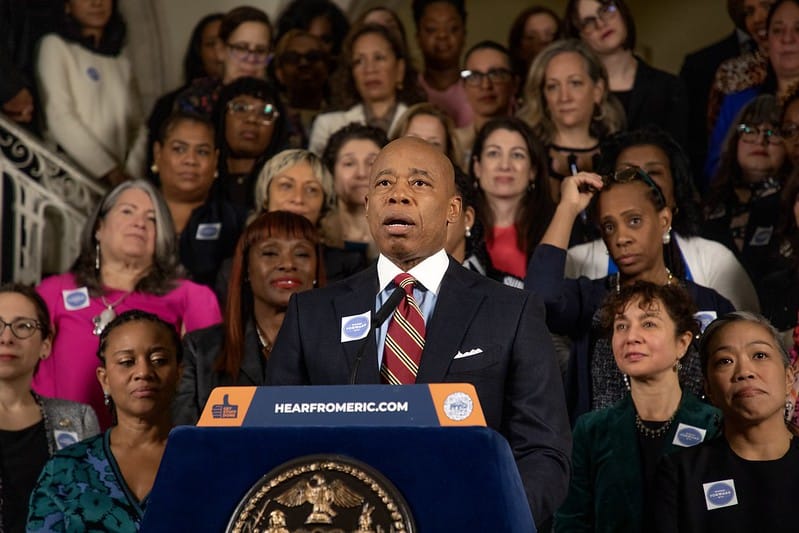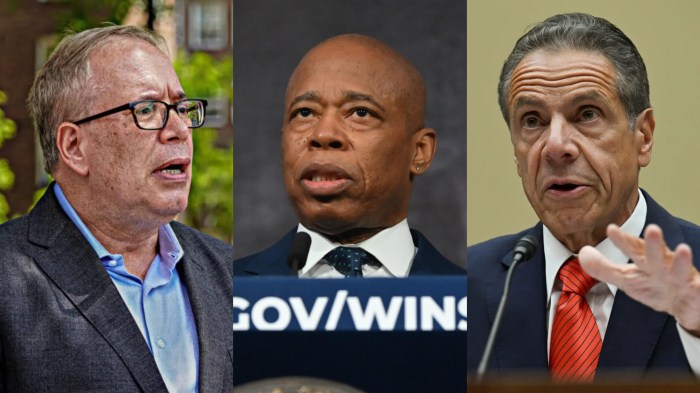Mayor Eric Adams on Thursday released details of a $43 million plan designed to advance women and gender equity in New York City.
The plan dubbed “Women Forward NYC: An Action Plan for Gender Equity,” which Adams first announced during his State of the City address in the Bronx on Wednesday, is built around 42 initiatives that span three areas: economic mobility, women’s health and public safety and housing.
“We’re taking steps to become a leader on gender equity, with the ambitious goal of becoming the most women forward city in America,” Adams said, during a City Hall news conference on Thursday morning.
The mayor said he is seeking to combat pervasive issues such as gender-based pay disparities — with women still earning 88 cents for every dollar a man makes in New York state, according to the state Department of Labor — and disproportionately high rates of maternal and infant mortality among birthing people of color.
“Our plan reduces gender disparities by connecting women of all ages to professional development in higher paying jobs,” Adams said. “It removes barriers to sexual, reproductive and chronic health care. It reduces domestic and gender-based violence against women and it provides wraparound holistic housing services with a focus on formerly incarcerated women and domestic gender based violence survivors.”
Some of the new initiatives embedded in the plan include a financial literacy training program for young girls living in homeless shelters, mental health services for pre and post natal birthing people in areas with high rates of maternal and infant mortality and an expansion of a program that provides domestic violence survivors with home alarm systems.
The plan is supported by a combination of roughly $28 million in city funds, over $1 million in private dollars and close to $14 million in federal grant money, according to Maria Torres-Springer, the deputy mayor for housing, economic development and workforce. The private dollars come from some individual donors and organizations that support city agencies, Torres-Springer said.
“If we are to make a dent in that pay gap, in that statistic about the incidence of maternal mortality in Black women, we have to make a very strong downpayment and have a comprehensive plan and that’s what this is,” Torres-Springer said.
Adams said the plan builds on another effort, focussed specifically on women’s health, that he announced around this time last year.
“This is a continuation that is showing that this was not a one and done,” he said. “We continue to grow, we continue to expand and that is the whole purpose of this.”
One way the latest plan seeks to advance the previous one is by putting more funding toward free medication abortion services offered at some of the city’s sexual health clinics, according to the mayor’s office.
However, while some advocates and lawmakers commended the mayor for trying to address gender equity issues, they also argued he has recently taken actions that undermine that very goal.
Rebecca Bailin, executive director of New Yorkers United for Child Care, said the mayor’s own recent budget cuts to the city’s universal Pre-K and 3-K programs, which total nearly $170 million, are in “direct opposition” to the aims of his gender equity plan.
“There is no equality without affordable child care for moms,” Bailin said, in a statement. “Yet since entering office, the mayor has made cut after cut to Pre-K and 3-K — programs we know help women thrive economically, in the workforce and beyond. If he wants to help New York’s women, the mayor must fully restore pre-K and 3-K funding and invest in universal childcare. The Mayor cannot promise to move women forward, while taking active steps that hold women back.”




































